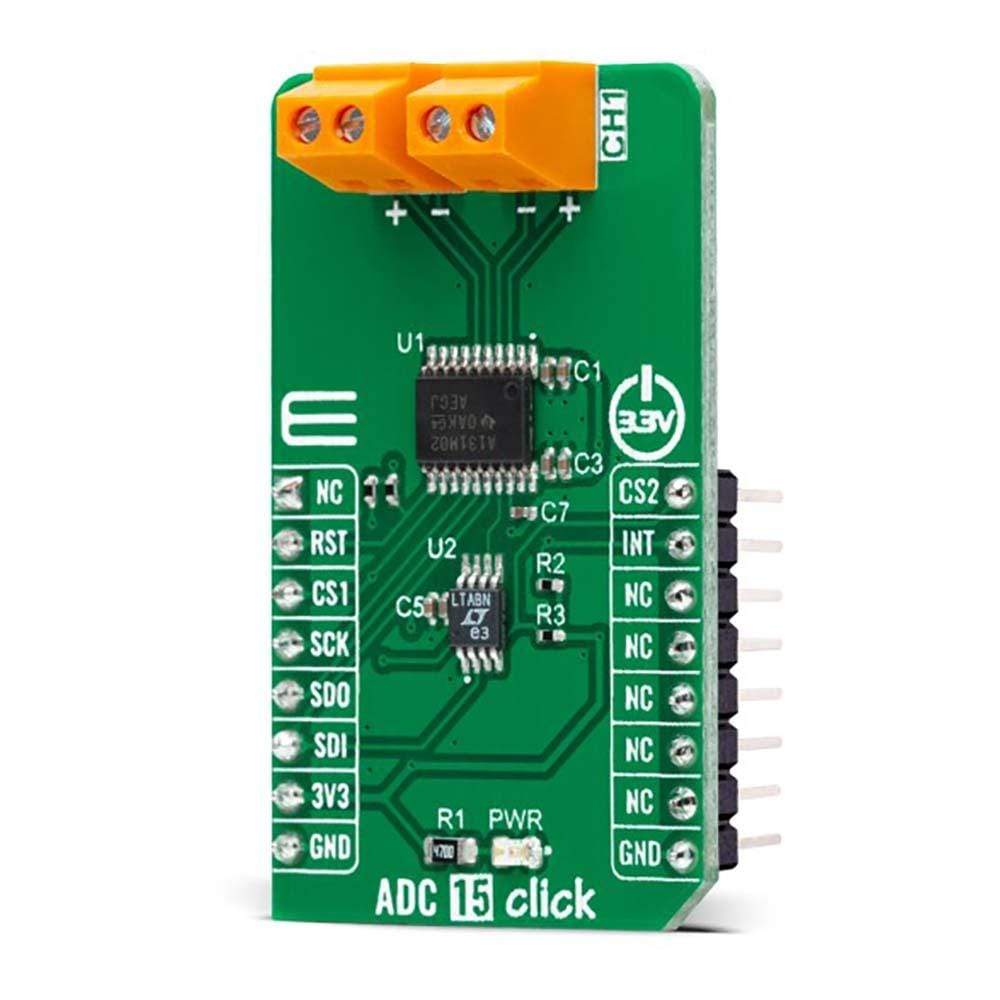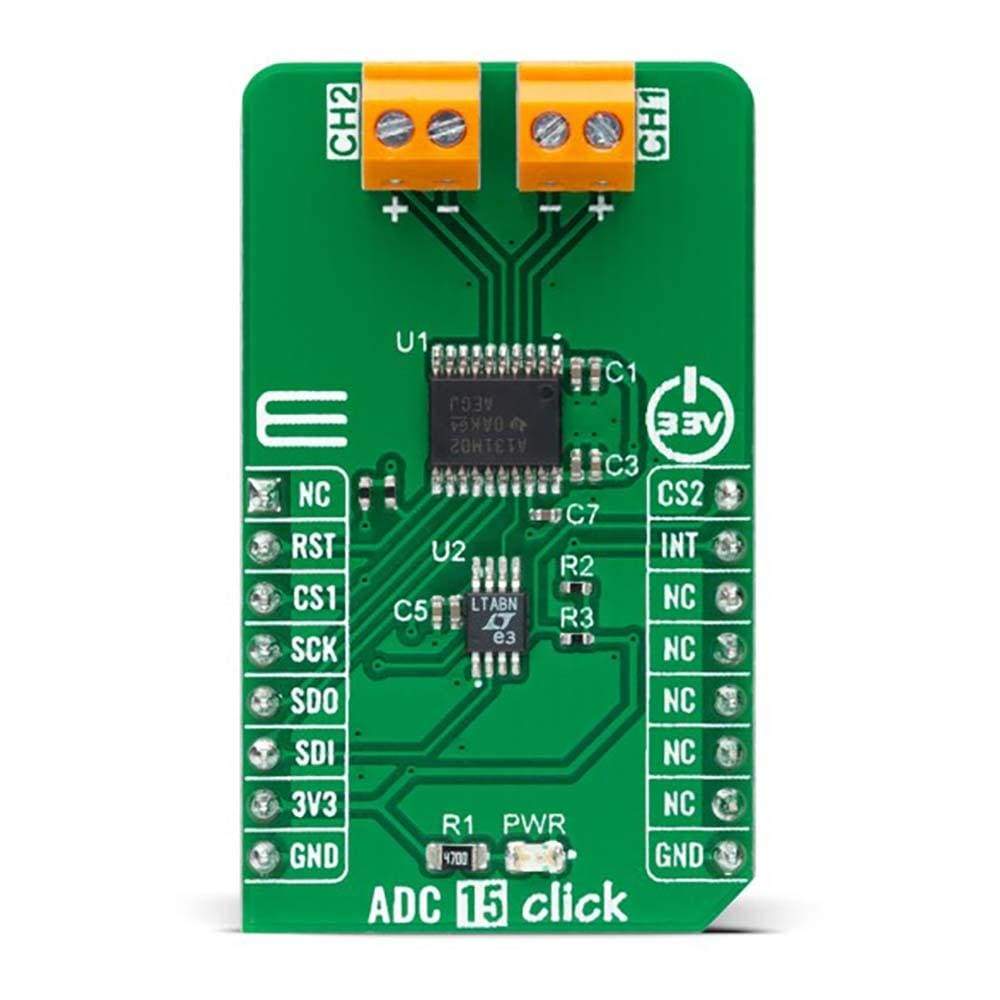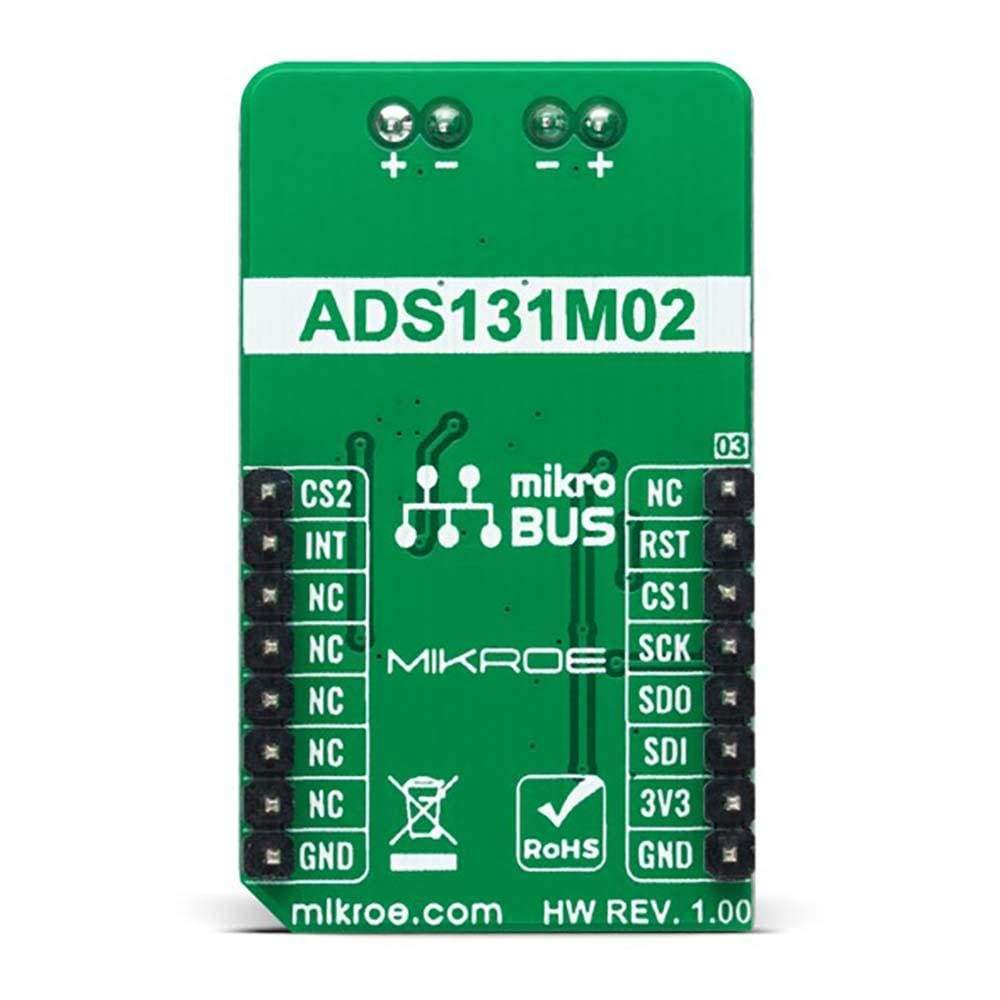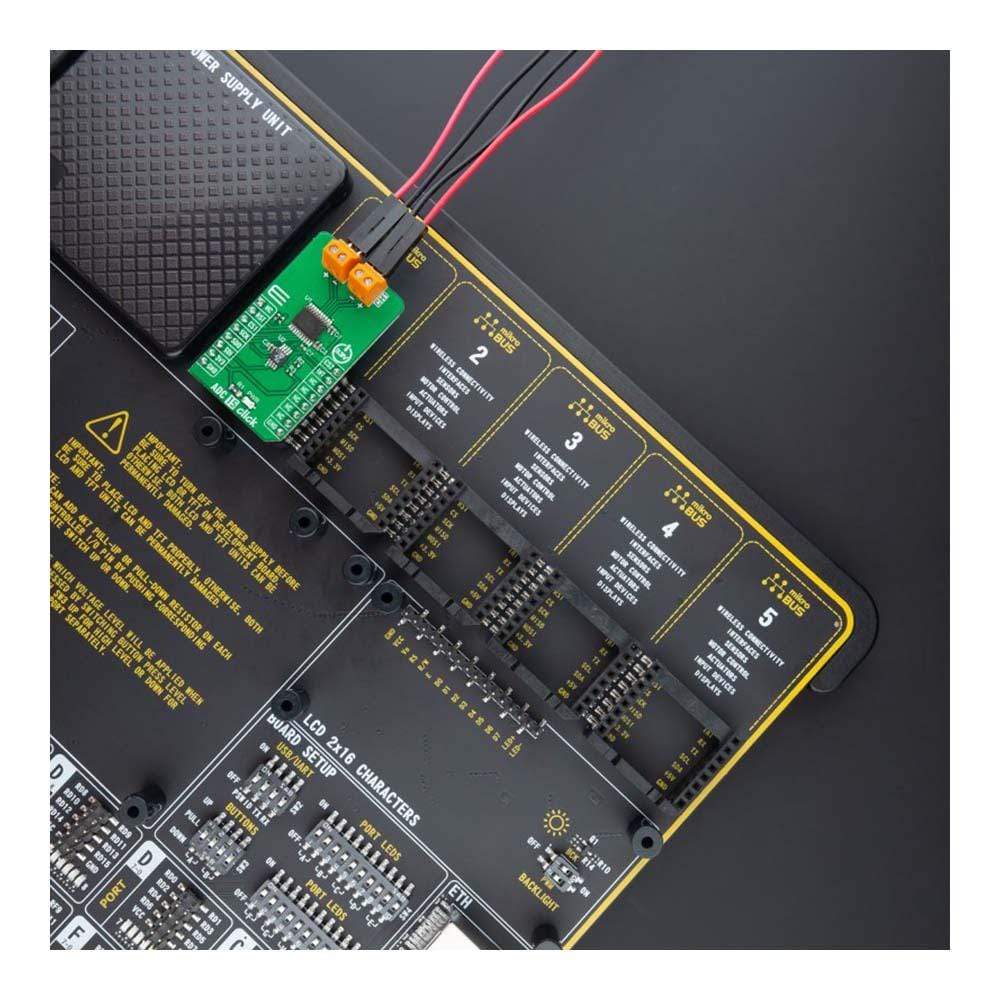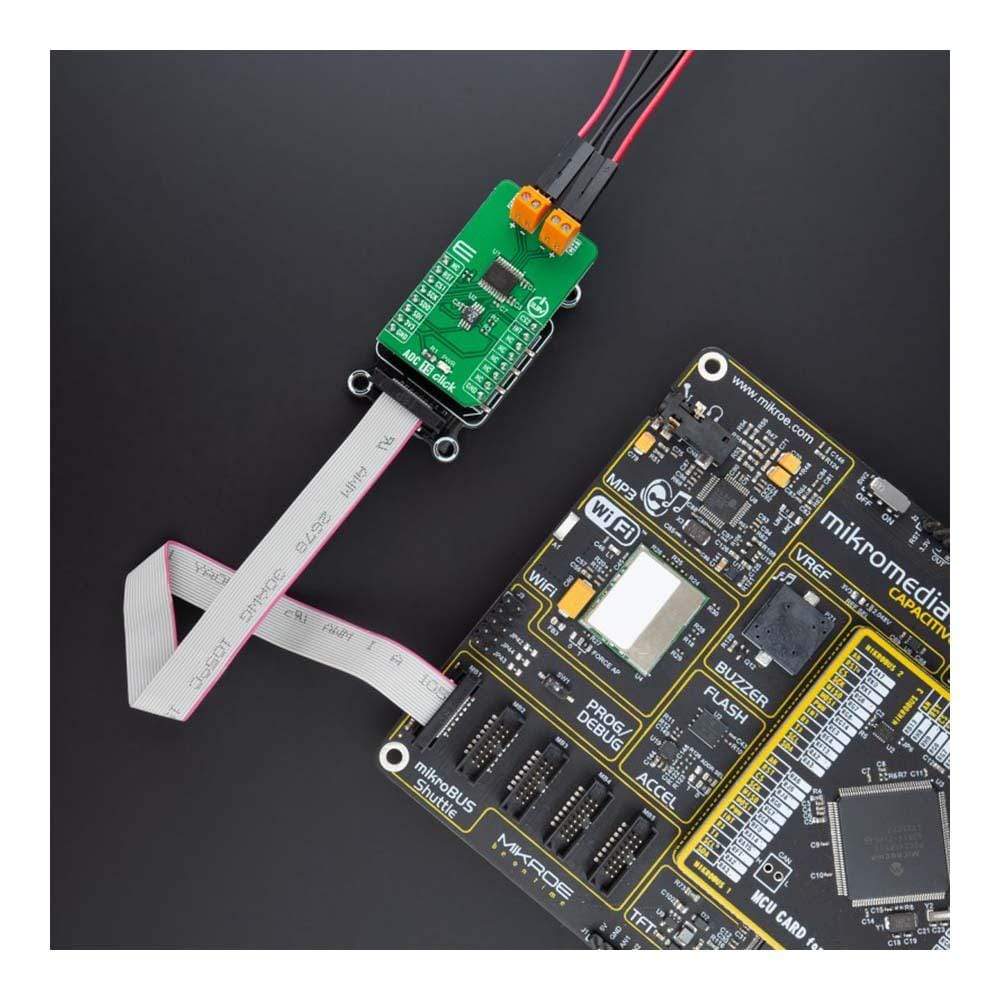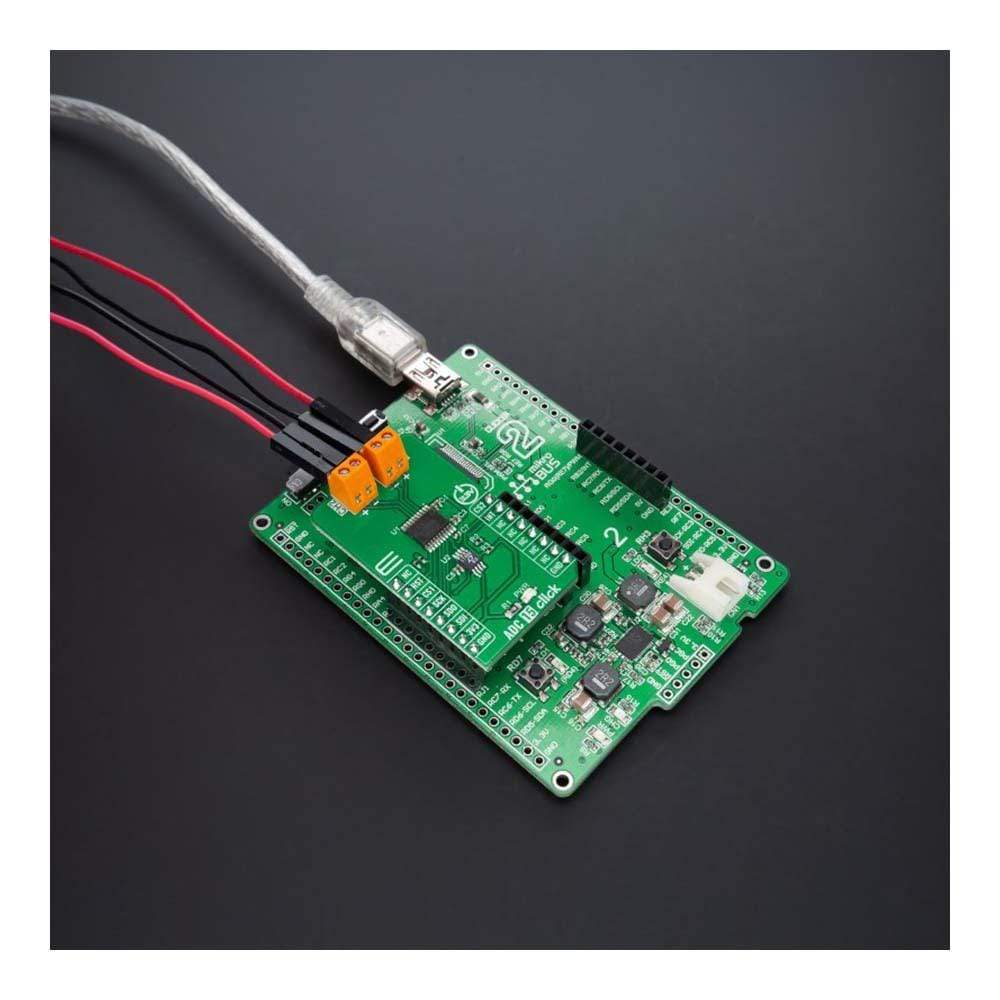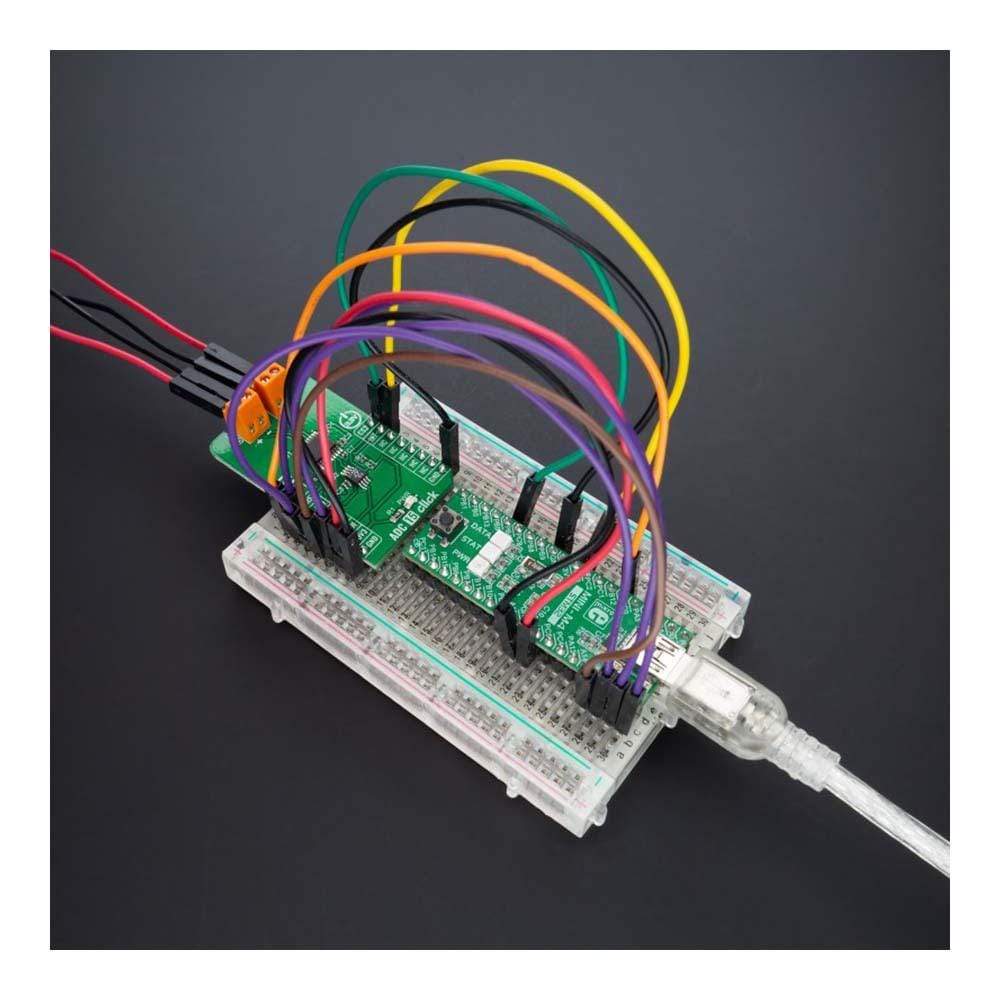
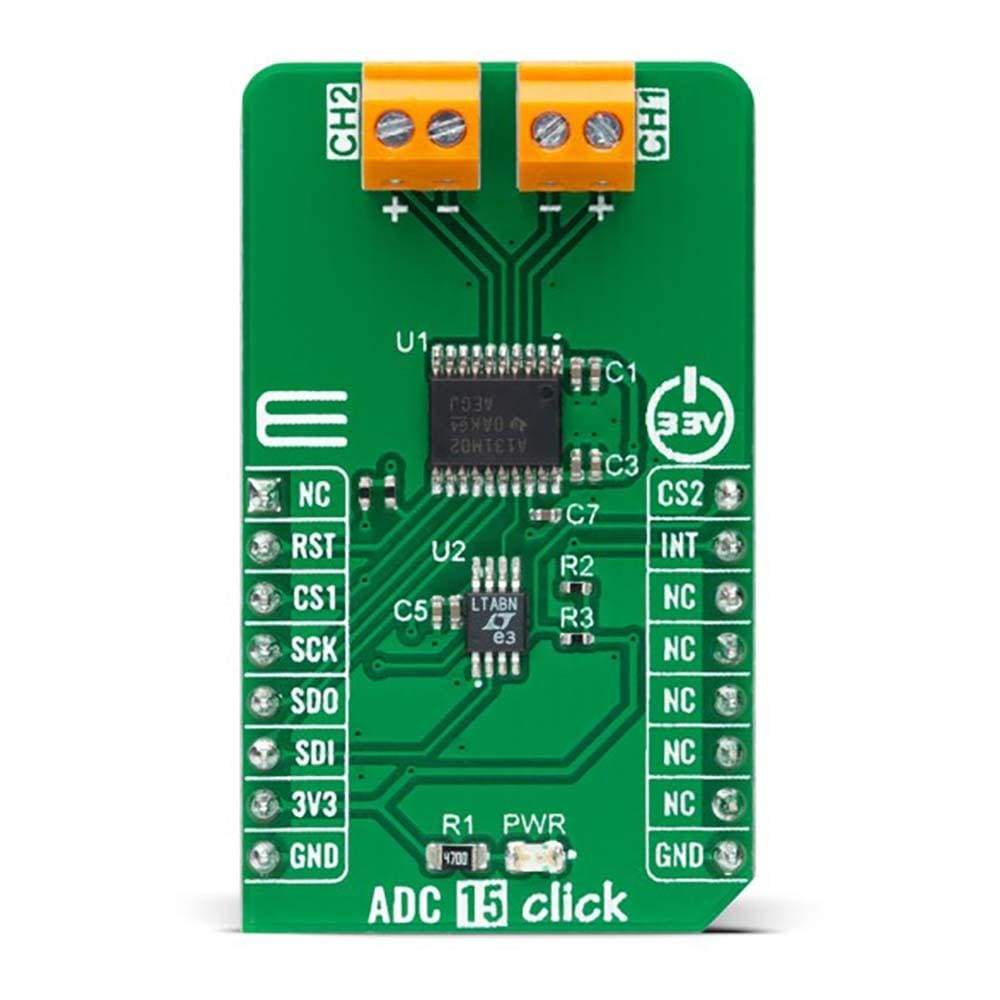
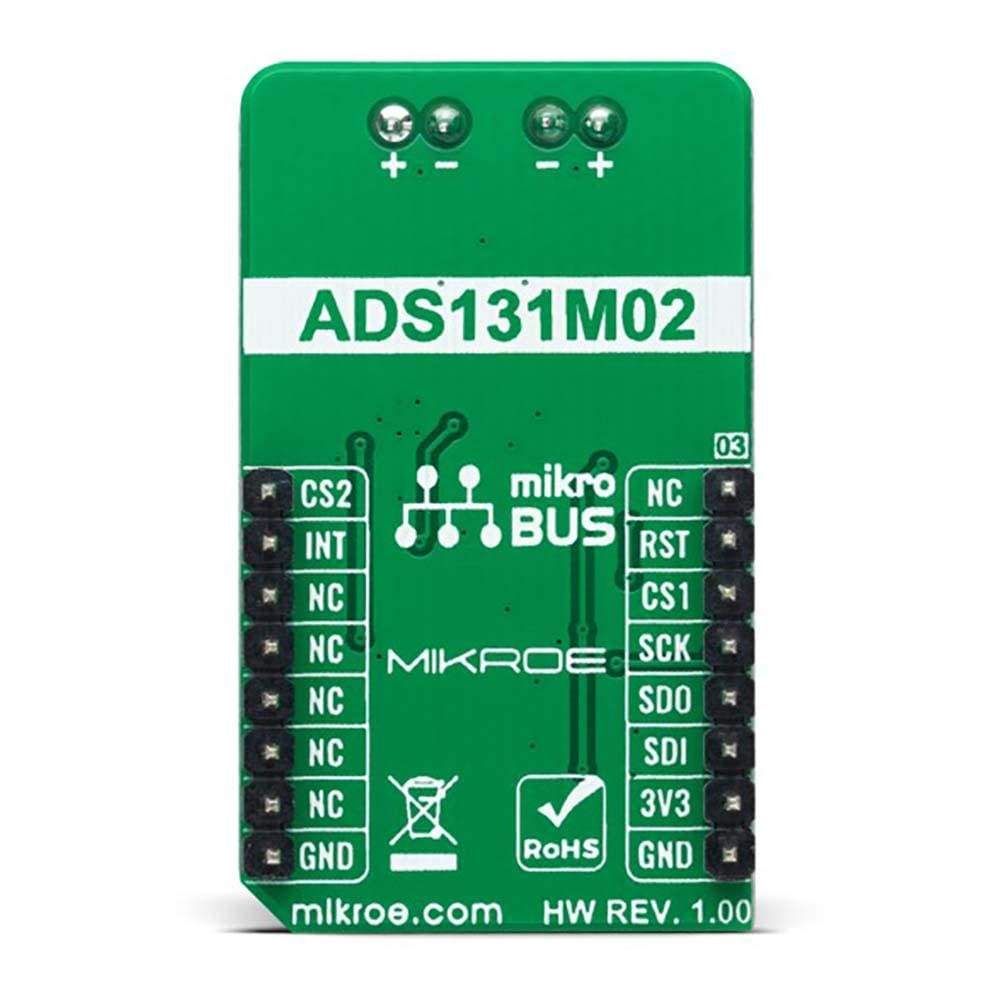
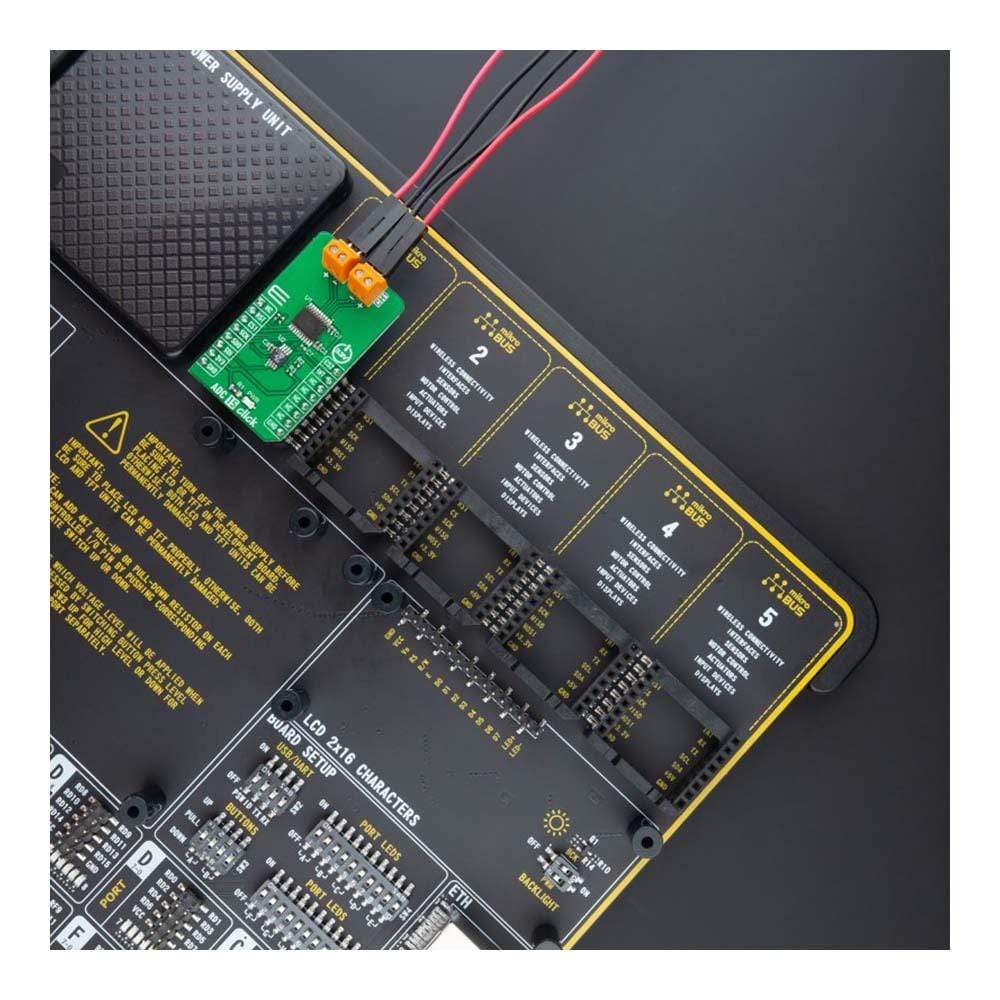
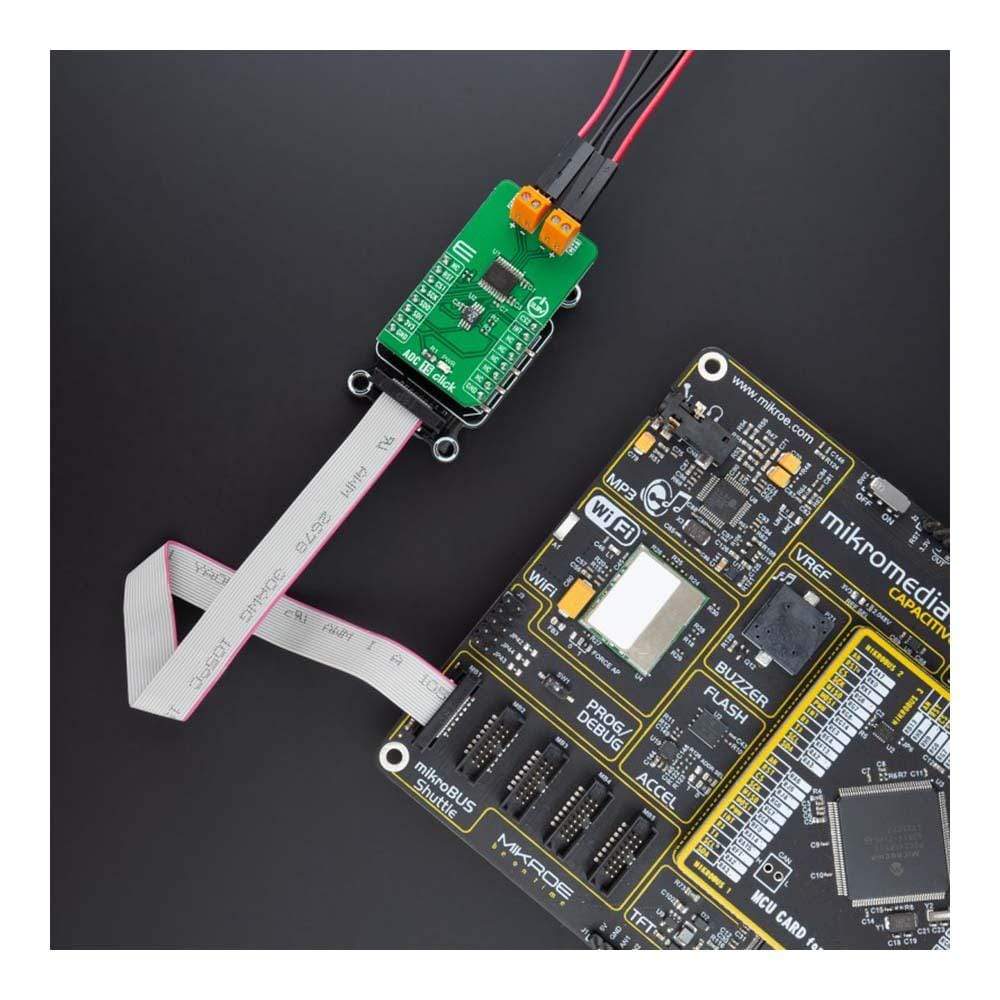
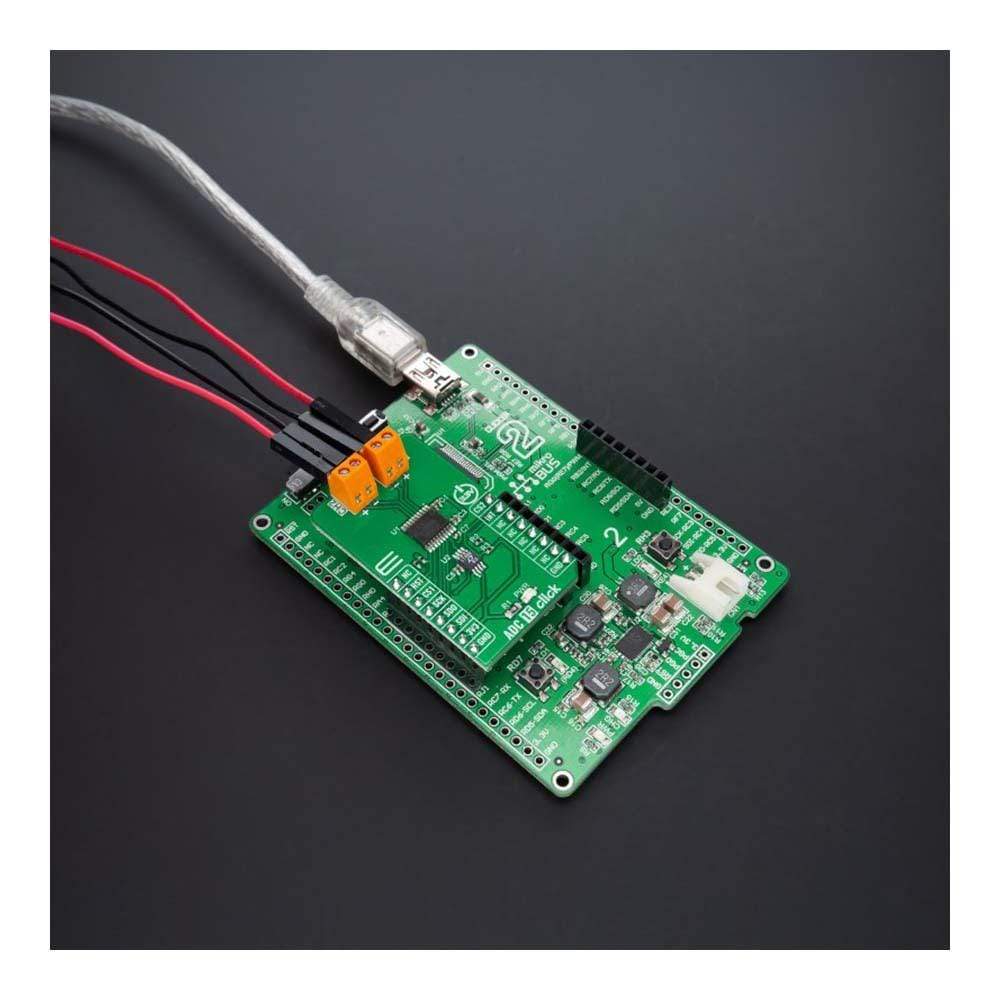
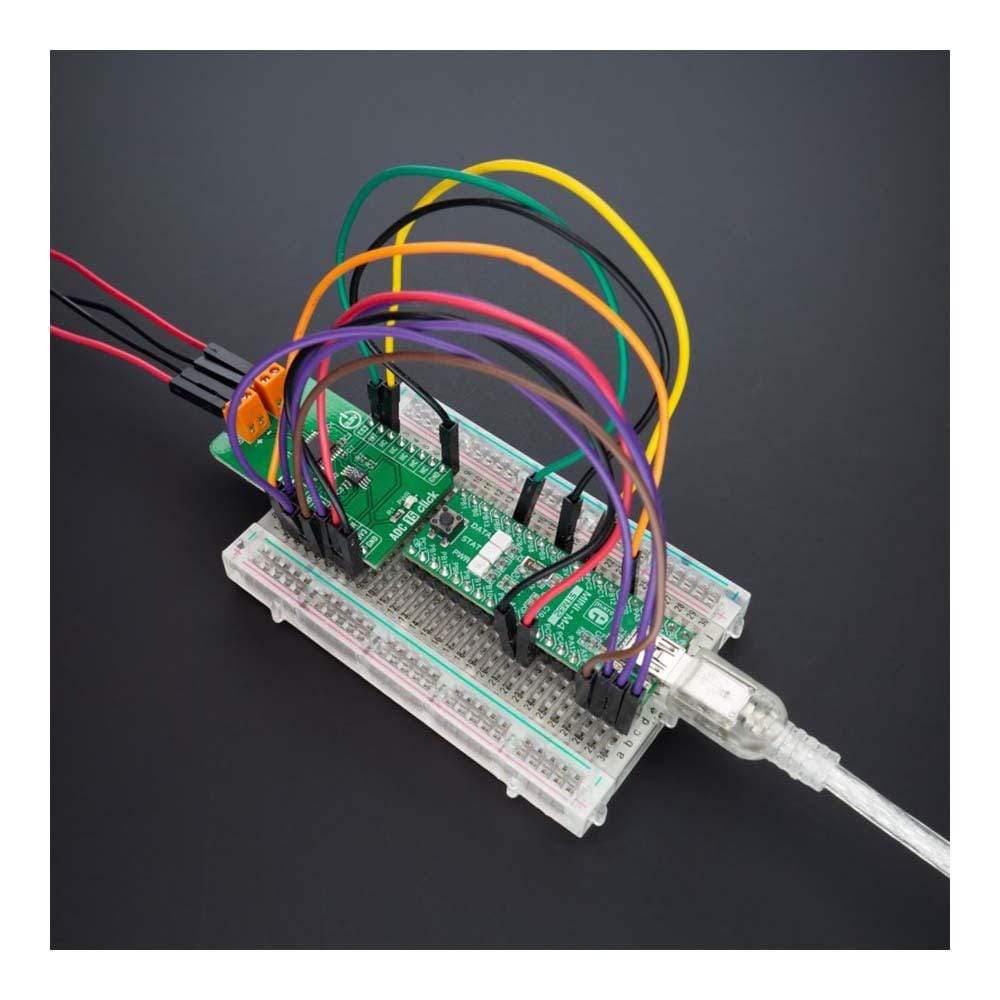
Key Features
Overview
The ADC 15 Click Board™ is a compact add-on board that contains a high-performance data converter. This board features the ADS131M02, a two-channel, simultaneously sampling, 24-bit, delta-sigma (ΔΣ), analogue-to-digital converter from Texas Instruments. The ADC inputs can be independently configured via serial peripheral interface depending on the sensor input. A low noise, programmable gain amplifier (PGA) provides gains ranging from 1 to 128 to amplify low-level signals. Additionally, this ADC integrates channel-to-channel phase, offset and gain calibration registers to help remove signal-chain errors alongside a low-drift, 1.2V integrated reference.
The ADC 15 Click Board™ offers a wide dynamic range, low power, and energy-measurement-specific features, making the device an excellent fit for energy metering, power metrology, and circuit breaker applications.
Downloads
How Does The ADC 15 Click Board™ Work?
The ADC 15 Click Board™ as its foundation uses the ADS131M02, a low-power, two-channel, simultaneously sampling, 24-bit, delta-sigma (ΔΣ) analogue-to-digital converter (ADC) with a low-drift internal reference voltage from Texas Instruments. The dynamic range, size, feature set, and power consumption are optimized for cost-sensitive applications requiring simultaneous sampling. An integrated negative charge pump allows absolute input voltages as low as -1.3 V, which enables measurements of input signals varying around the ground with a single-ended power supply.
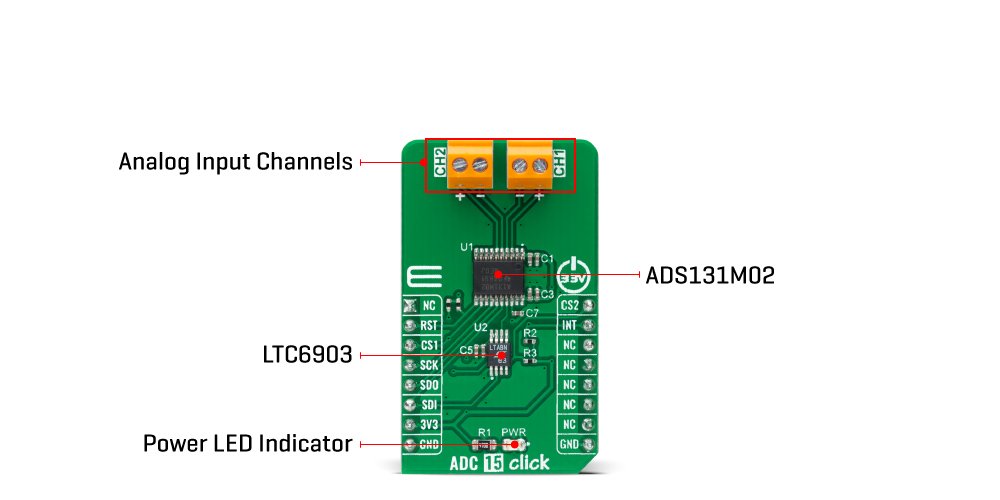
The ADS131M02 features a programmable gain amplifier (PGA) with gains up to 128. An integrated input pre-charge buffer enabled at gains greater than 4 ensures high input impedance at high PGA gain settings. The ADC receives its reference voltage from an integrated 1.2V reference, allowing differential input voltages as large as the reference. Each channel on the ADS131M02 contains a digital decimation filter that demodulates the output of the ΔΣ modulators. The filter enables data rates as high as 32 kSPS per channel in high-resolution mode. The relative phase of the samples can be configured between channels, thus allowing an accurate compensation for the sensor phase response. Offset and gain calibration registers can be programmed to adjust output samples for measured offset and gain errors automatically.
The ADC 15 Click Board™ communicates with MCU through a standard SPI interface to read the conversion data, configure and control the ADS131M02, supporting the most common SPI mode - SPI Mode 1. To normally run the ADS131M02, an LVCMOS clock must be continuously provided at the CLKIN pin, which is achieved with the LTC6903 programmable oscillator activated via the CS2 pin routed to the PWM pin on the mikroBUS™ socket. The frequency of the clock can be scaled in conjunction with the power mode to provide a trade-off between power consumption and dynamic range. Selection of the bits in the CLOCK register allows the device to be configured in one of three power modes: high-resolution (HR) mode, low-power (LP) mode, and very low-power (VLP) mode.
In addition, the ADC 15 Click Board™ also uses features such as data-ready/interrupt routed to the INT pin on the mikroBUS™ socket, that serves as a flag to the host to indicate that new conversion data are available, and Reset routed to the RST pin that allows for a hardware device reset.
The ADC 15 Click Board™ can be operated only with a 3.3V logic voltage level. The board must perform appropriate logic voltage level conversion before use with MCUs with different logic levels. However, the Click board™ comes equipped with a library containing functions and an example code that can be used, as a reference, for further development.
SPECIFICATIONS
| Type | ADC |
| Applications | Can be used for energy metering, power metrology, and circuit breaker applications |
| On-board modules | ADS131M02 - low-power, two-channel, simultaneously sampling, 24-bit, delta-sigma (ΔΣ) analogue-to-digital converter (ADC) with a low-drift internal reference voltage from Texas Instruments |
| Key Features | Two simultaneously sampling differential inputs, programmable gain and data rate, integrated negative charge pump allows input signals below ground, wide dynamic range, low power, and energy-measurement-specific features, and many more |
| Interface | SPI |
| Compatibility | mikroBUS |
| Click board size | M (42.9 x 25.4 mm) |
| Input Voltage | 3.3V |
PINOUT DIAGRAM
This table shows how the pinout of the ADC 15 Click Board™ corresponds to the pinout on the mikroBUS™ socket (the latter shown in the two middle columns).
| Notes | Pin |  |
Pin | Notes | |||
|---|---|---|---|---|---|---|---|
| NC | 1 | AN | PWM | 16 | CS2 | LTC6903 Enable | |
| Reset | RST | 2 | RST | INT | 15 | INT | Data-Ready / Interrupt |
| SPI Chip Select | CS | 3 | CS | RX | 14 | NC | |
| SPI Clock | SCK | 4 | SCK | TX | 13 | NC | |
| SPI Data OUT | SDO | 5 | MISO | SCL | 12 | NC | |
| SPI Data IN | SDI | 6 | MOSI | SDA | 11 | NC | |
| Power Supply | 3.3V | 7 | 3.3V | 5V | 10 | NC | |
| Ground | GND | 8 | GND | GND | 9 | GND | Ground |
ONBOARD SETTINGS AND INDICATORS
| Label | Name | Default | Description |
|---|---|---|---|
| LD1 | PWR | - | Power LED Indicator |
ADC 15 CLICK ELECTRICAL SPECIFICATIONS
| Description | Min | Typ | Max | Unit |
|---|---|---|---|---|
| Supply Voltage VCC | - | 3.3 | - | V |
| Analog Input Voltage Range | -1.3 | - | 3.6 | V |
| Resolution | 24 | - | - | bit |
| Data Rate | - | - | 64 | kSPS |
| Operating Temperature Range | -40 | +25 | +125 | °C |
| General Information | |
|---|---|
Part Number (SKU) |
MIKROE-4890
|
Manufacturer |
|
| Physical and Mechanical | |
Weight |
0.02 kg
|
| Other | |
Country of Origin |
|
HS Code Customs Tariff code
|
|
EAN |
8606027384356
|
Warranty |
|
Frequently Asked Questions
Have a Question?
Be the first to ask a question about this.

